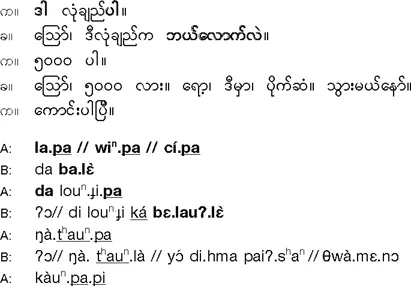
Colloquial Burmese
The Complete Course for Beginners
San San Hnin Tun, Patrick McCormick
- 312 Seiten
- English
- ePUB (handyfreundlich)
- Über iOS und Android verfügbar
Colloquial Burmese
The Complete Course for Beginners
San San Hnin Tun, Patrick McCormick
Über dieses Buch
Colloquial Burmese provides a step-by-step course in Burmese as it is written and spoken today. Combining a user-friendly approach with a thorough treatment of the language, it equips learners with the essential skills needed to communicate confidently and effectively in Burmese in a broad range of situations. No prior knowledge of the language is required.
Key features include:
-
- progressive coverage of speaking, listening, reading and writing skills
- structured, jargon-free explanations of grammar
- an extensive range of focused and stimulating exercises
- realistic and entertaining dialogues covering a broad variety of scenarios
- useful vocabulary lists throughout the text
- review chapters at intervals throughout the text providing motivational checklists of language points covered
- an overview of the sounds of Burmese
- A full answer key and glossary at the back of the book
Balanced, comprehensive and rewarding, Colloquial Burmese will be an indispensable resource both for independent learners and for students taking courses in Burmese.
Audio material to accompany the course is available to download free in MP3 format from www.routledge.com/cw/colloquials. Recorded by native speakers, the audio material features the dialogues and texts from the book and will help develop your listening and pronunciation skills.
Häufig gestellte Fragen
Information
Unit 1





Dialogue 1


